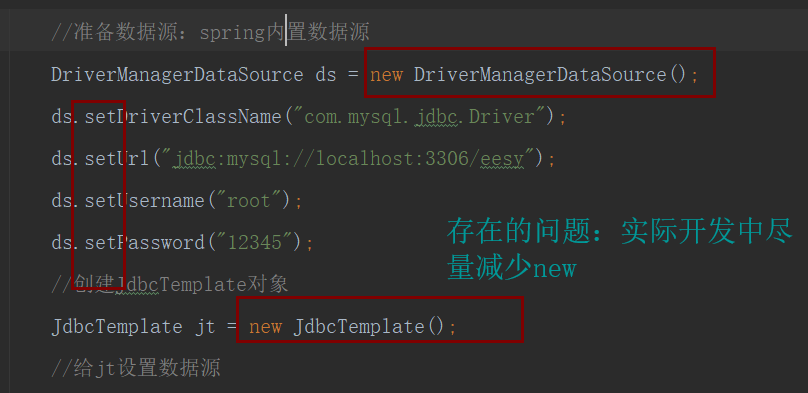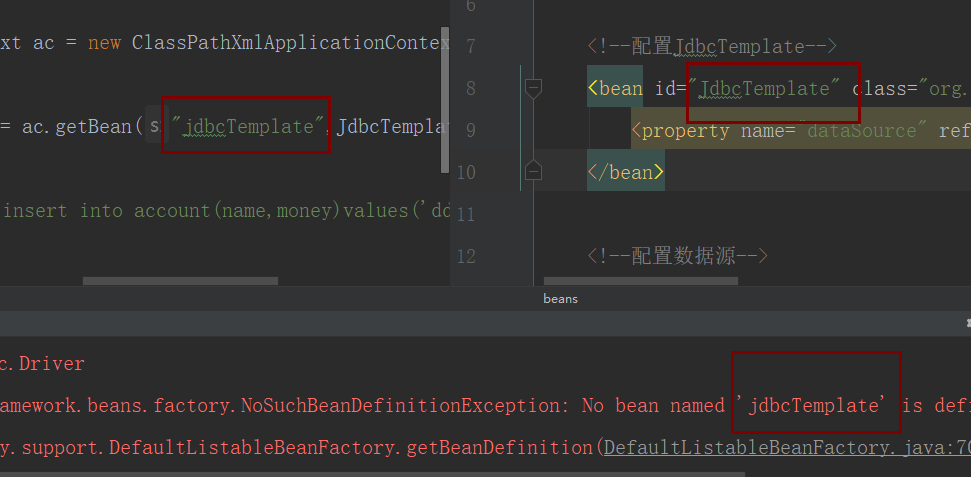Spring笔记4
2019-08-16 10:51:23来源:博客园 阅读 ()

Spring笔记4
Spring中的JdbcTemplate
JdbcTemplate:他是spring框架中提供的一个对象,是对原始Jdbc API对象的简单封装。
JdbcTemplate的作用:用于和数据库交互的,实现对表的CRUD操作
JdbcTemplate的入门
导入相关的坐标
<packaging>jar</packaging>
<dependencies>
<dependency>
<groupId>org.springframework</groupId>
<artifactId>spring-context</artifactId>
<version>4.2.8.RELEASE</version>
</dependency>
<dependency>
<groupId>org.springframework</groupId>
<artifactId>spring-jdbc</artifactId>
<version>5.0.3.RELEASE</version>
</dependency>
<dependency>
<groupId>org.springframework</groupId>
<artifactId>spring-tx</artifactId>
<version>5.0.3.RELEASE</version>
</dependency>
<dependency>
<groupId>mysql</groupId>
<artifactId>mysql-connector-java</artifactId>
<version>5.1.32</version>
</dependency>
</dependencies>账户实体类的建立
package com.itheima.domain;
import java.io.Serializable;
//账户的实体类
public class Account implements Serializable {
private Integer id;
private String name;
private Float money;
public Integer getId() {
return id;
}
public void setId(Integer id) {
this.id = id;
}
public String getName() {
return name;
}
public void setName(String name) {
this.name = name;
}
public Float getMoney() {
return money;
}
public void setMoney(Float money) {
this.money = money;
}
@Override
public String toString() {
return "Account{" +
"id=" + id +
", name='" + name + '\'' +
", money=" + money +
'}';
}
}操作数据库
package com.itheima.jdbctemplate;
import org.springframework.jdbc.core.JdbcTemplate;
import org.springframework.jdbc.datasource.DriverManagerDataSource;
//JdbcTemplate的最基本用法
public class JdbcTemplateDemo1 {
public static void main(String[] args) {
//准备数据源:spring内置数据源
DriverManagerDataSource ds = new DriverManagerDataSource();
ds.setDriverClassName("com.mysql.jdbc.Driver");
ds.setUrl("jdbc:mysql://localhost:3306/eesy");
ds.setUsername("root");
ds.setPassword("12345");
//创建JdbcTemplate对象
JdbcTemplate jt = new JdbcTemplate();
//给jt设置数据源
jt.setDataSource(ds);
//执行操作
jt.execute("insert into account(name,money)values('ccc',1000)");
}
}

JdbcTemplate在spring的ioc中使用
配置bean
<?xml version="1.0" encoding="UTF-8"?>
<beans xmlns="http://www.springframework.org/schema/beans"
xmlns:xsi="http://www.w3.org/2001/XMLSchema-instance"
xsi:schemaLocation="http://www.springframework.org/schema/beans
http://www.springframework.org/schema/beans/spring-beans.xsd">
<!--配置JdbcTemplate-->
<bean id="JdbcTemplate" class="org.springframework.jdbc.core.JdbcTemplate">
<property name="dataSource" ref="dataSource"></property>
</bean>
<!--配置数据源-->
<bean id="dataSource" class="org.springframework.jdbc.datasource.DriverManagerDataSource">
<property name="driverClassName" value="com.mysql.jdbc.Driver"></property>
<property name="url" value="jdbc:mysql://localhost:3306/eesy"></property>
<property name="username" value="root"></property>
<property name="password" value="12345"></property>
</bean>
</beans>测试是否可以操作数据库
报错:
NoSuchBeanDefinitionException: No bean named 'jdbcTemplate' is defined原因:xxxx没有定义,区分大小写:

package com.itheima.jdbctemplate;
import org.springframework.context.ApplicationContext;
import org.springframework.context.support.ClassPathXmlApplicationContext;
import org.springframework.jdbc.core.JdbcTemplate;
import org.springframework.jdbc.datasource.DriverManagerDataSource;
//JdbcTemplate的最基本用法
public class JdbcTemplateDemo1 {
public static void main(String[] args) {
//获取容器
ApplicationContext ac = new ClassPathXmlApplicationContext("bean.xml");
//获取对象
JdbcTemplate jt = ac.getBean("JdbcTemplate",JdbcTemplate.class);
//执行操作
jt.execute("insert into account(name,money)values('ddd',13240)");
}
}
spring中基于xml的声明事务控制步骤
<?xml version="1.0" encoding="UTF-8"?>
<beans xmlns="http://www.springframework.org/schema/beans"
xmlns:xsi="http://www.w3.org/2001/XMLSchema-instance"
xmlns:aop="http://www.springframework.org/schema/aop"
xmlns:tx="http://www.springframework.org/schema/tx"
xsi:schemaLocation="
http://www.springframework.org/schema/beans
http://www.springframework.org/schema/beans/spring-beans.xsd
http://www.springframework.org/schema/tx
http://www.springframework.org/schema/tx/spring-tx.xsd
http://www.springframework.org/schema/aop
http://www.springframework.org/schema/aop/spring-aop.xsd">
<!-- 配置业务层-->
<bean id="accountService" class="com.itheima.service.impl.AccountServiceImpl">
<property name="accountDao" ref="accountDao"></property>
</bean>
<!-- 配置账户的持久层-->
<bean id="accountDao" class="com.itheima.dao.impl.AccountDaoImpl">
<property name="dataSource" ref="dataSource"></property>
</bean>
<!-- 配置数据源-->
<bean id="dataSource" class="org.springframework.jdbc.datasource.DriverManagerDataSource">
<property name="driverClassName" value="com.mysql.jdbc.Driver"></property>
<property name="url" value="jdbc:mysql://localhost:3306/eesy"></property>
<property name="username" value="root"></property>
<property name="password" value="12345"></property>
</bean>
<!--spring中基于xml的声明事务控制步骤步骤-->
<!--1.配置事务管理器-->
<bean id="transactionManager" class="org.springframework.jdbc.datasource.DataSourceTransactionManager">
<property name="dataSource" ref="dataSource"></property>
</bean>
<!--2.配置事务的通知:
需要导入事务的约束
属性id:给事务通知一个唯一标识
属性transaction-manager:给事务通知提供一个事务管理器引用
-->
<tx:advice id="txAdvice" transaction-manager="transactionManager">
<!--配置事务的属性
isolation:用于指定事务的隔离级别,默认值是DEFAULT,表示使用数据库的默认隔离级别
propagation:用于指定事务的传播行为。默认值是REQUIRED,表示一定会有事务,增删改的选择。查询方法可以选择SUPPORTS
read-only:用于指定事务是否只读。只有查询方法才能设置true.默认值是false.表示只读
timeout:用于指定事务的超时时间,默认值-1.表示永不超时。如果指定了数值,以秒为单位
rollback-for:用于指定一个异常,当产生该异常是,事务回滚,产生其他异常是,事务部回滚,没有默认值,表示任何异常都回滚
no-rollback-for:用于指定一个异常,当产生该异常时,事务不回滚,产生其他异常时事务回滚,没有默认值。表示任何异常都回滚
-->
<tx:attributes>
<tx:method name="*" propagation="REQUIRED" read-only="false"/>
<tx:method name="find*" propagation="SUPPORTS" read-only="true"></tx:method>
</tx:attributes>
</tx:advice>
<!--3.配置AOP中的通用切入点表达式
-->
<aop:config>
<aop:pointcut id="pt1" expression="execution(* com.itheima.service.impl.*.*(..))"></aop:pointcut>
<!--4.建立事务通知和切入点表达式的对应关系-->
<aop:advisor advice-ref="txAdvice" pointcut-ref="pt1"></aop:advisor>
</aop:config>
</beans>原文链接:https://www.cnblogs.com/train99999/p/11219654.html
如有疑问请与原作者联系
标签:
版权申明:本站文章部分自网络,如有侵权,请联系:west999com@outlook.com
特别注意:本站所有转载文章言论不代表本站观点,本站所提供的摄影照片,插画,设计作品,如需使用,请与原作者联系,版权归原作者所有
上一篇:面向对象学生类和手机类的使用
下一篇:反射为单级属性赋值
- Spring系列.ApplicationContext接口 2020-06-11
- springboot2配置JavaMelody与springMVC配置JavaMelody 2020-06-11
- 给你一份超详细 Spring Boot 知识清单 2020-06-11
- SpringBoot 2.3 整合最新版 ShardingJdbc + Druid + MyBatis 2020-06-11
- 掌握SpringBoot-2.3的容器探针:实战篇 2020-06-11
IDC资讯: 主机资讯 注册资讯 托管资讯 vps资讯 网站建设
网站运营: 建站经验 策划盈利 搜索优化 网站推广 免费资源
网络编程: Asp.Net编程 Asp编程 Php编程 Xml编程 Access Mssql Mysql 其它
服务器技术: Web服务器 Ftp服务器 Mail服务器 Dns服务器 安全防护
软件技巧: 其它软件 Word Excel Powerpoint Ghost Vista QQ空间 QQ FlashGet 迅雷
网页制作: FrontPages Dreamweaver Javascript css photoshop fireworks Flash
